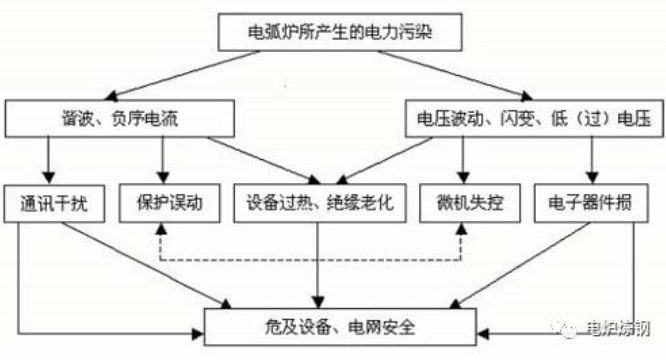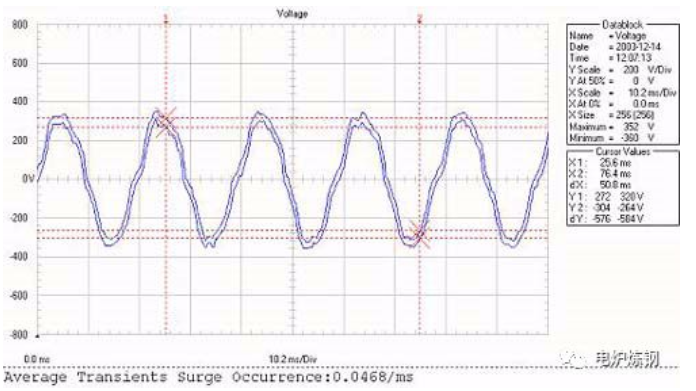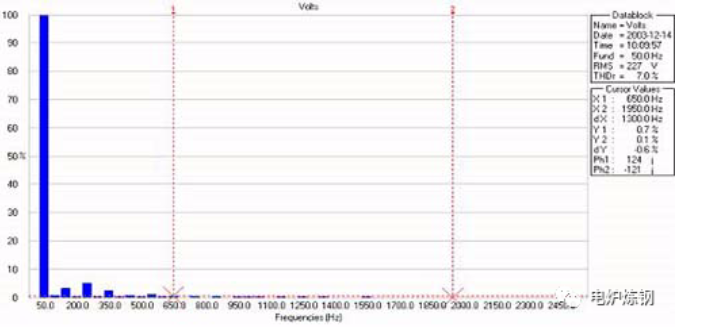Paper
Working principle of electric arc furnace and its influence on power quality
Updated: 2022-04-26 Attention:
1. Classification and working principle of electric arc furnace
Electric arc furnace is an electric furnace that uses electric arc energy to smelt metal. The electric arc furnace used in industry can be divided into three categories: the first is the direct heating type. The electric arc occurs between the special electrode rod and the melted charge, and the charge is directly heated by the electric arc. It is mainly used for steelmaking, followed by smelting iron, copper, refractories, refining liquid steel, etc.
The second type is indirect heating type. The arc occurs between two special electrode rods. The furnace charge is radiated by the arc and is used for smelting copper and copper alloy. This kind of furnace has high noise and poor smelting quality, and has been gradually replaced by other furnaces.
The third type is called submerged arc furnace, which uses high resistivity ore as raw material. During the working process, the lower part of the electrode is generally buried in the furnace charge. Its heating principle is: it not only uses the heat generated by the charge resistance when the current passes through the charge, but also uses the heat generated by the arc between the electrode and the charge. So it is also called arc resistance furnace.
2. Composition and equipment of electric arc furnace
Furnace transformer
The transformer for arc steelmaking shall be able to adjust the voltage and current separately according to the smelting requirements, and can withstand the impact of working short-circuit current.
Many factors should be considered in the selection of rated voltage of electric furnace transformer. If the primary side voltage is higher, the system reactance is small and the short-circuit capacity is large, which can reduce flicker, but the cost of distribution equipment must be increased. If the secondary wall is longer, the electric arc efficiency is higher.
Generally, the secondary side of electric furnace transformer is low voltage (tens to hundreds of volts) and high current (thousands to tens of thousands of AMPS). In order to ensure the different needs of electric power in each smelting stage, the secondary voltage of the transformer should be able to be adjusted within the range of 50% ~ 70%, so they are designed into multi-level adjustable form. The adjustment methods include transformation, on load voltage regulation tap changer, etc. If the transformer capacity is less than 10MVA, no-load switching can be carried out; If the capacity is more than 10MVA, it shall generally be the on load voltage regulation mode. There are also three-phase tap devices set separately, and each phase is adjusted separately, which can ensure the three-phase heat energy balance in the furnace.
Compared with ordinary power transformer, the special transformer for electric furnace has the following characteristics: A. It has large overload capacity; b. High mechanical strength; c. Large short-circuit impedance; d. There are several secondary voltage levels; e. Large transformation ratio; f. The secondary voltage is low and the current is high.
The capacity ratio of electric furnace transformer and electric arc furnace is generally 0.4 ~ 1.2mva/t. The current control of electric arc furnace is achieved by the switching of winding taps on the high voltage side of electric arc furnace transformer and the lifting and lowering of electrodes.
reactor
In order to stabilize the arc and limit the short-circuit current, a reactance capacity equal to about 35% of the transformer capacity is required to be connected in series into the main circuit of the transformer. Large electric arc furnace transformer has its own reactance value to meet the needs without additional reactor; For transformers less than 10MVA, the reactance does not meet the requirements, so a reactor needs to be added at the primary side. The structural feature of the reactor is that even if the short-circuit current is passed, the iron core will not be magnetically saturated.
The reactor can be installed inside the electric furnace transformer, which is called internal type; It can also be made into an independent reactor installed outside the transformer, which is called external type. The electric furnace transformer is generally connected in series with reactor, so that the sum of transformer short-circuit impedance and reactor reactance reaches the standard value of 0.33 ~ 0.5 (based on the rated capacity of electric furnace transformer).
The electric furnace transformer with capacity less than 10MVA is sometimes equipped with series reactor on its high-voltage side to reduce short-circuit current and stabilize arc. For the electric furnace transformer with large capacity, its own leakage reactance is large enough and there is no need to connect reactors in series.
High voltage circuit breaker
The requirements of steelmaking electric arc furnace for high voltage circuit breaker are: large breaking capacity; Allow frequent action; Easy maintenance and long service life. Electric arc resistance furnace has stable load and continuous operation. High voltage circuit breakers with more or less oil are commonly used. Circuit breakers of steelmaking electric arc furnace often trip. Sulfur hexafluoride circuit breakers, electromagnetic air circuit breakers, vacuum circuit breakers, etc. are mostly used.
Current transformer
The secondary current of large steelmaking electric arc furnace is too large to be equipped with current transformer. Therefore, the current signals of the low-voltage side instrument and the automatic adjustment of electrode lifting are connected to the high-voltage side current transformer or to the third winding of the electric furnace transformer (variable transformation ratio).
Electromagnetic stirrer
In order to strengthen the reaction between molten steel and slag and make the temperature and composition of molten steel uniform, an electromagnetic stirrer is installed at the bottom of the steelmaking electric arc furnace.
The agitator consists of an iron core wound with two groups of coils. It itself is equivalent to the stator of the motor, and the liquid steel in the molten pool is equivalent to the rotor. The coil of the agitator is connected with two-phase low-frequency current that can generate phase-shifting magnetic field. The magnetic field generates induced current in the liquid steel. The moving magnetic field interacts with the induced current to make the liquid steel flow along the moving direction of the moving magnetic field under the promotion of electric power, so that the liquid steel can be stirred.
The bottom of the electric arc furnace with electromagnetic stirring shall be made of non-magnetic steel plate. In order to change the stirring force of the electromagnetic stirrer, a low-frequency power supply with adjustable frequency is required, and its frequency is adjusted within 0.3 ~ 0.5Hz. Crystal tube frequency conversion power supply is generally used. Capacitors shall be installed to improve the power factor, and reactors shall be installed to prevent resonance.
Through the analysis of the electrical characteristics of electric arc furnace equipment, the following conclusions can be drawn:
a) In order to prevent arc breaking during the operation of electric arc furnace, when the current is instantaneous zero, the arc voltage uh must be greater than the ignition voltage.
b) In order to limit the short-circuit current, the secondary circuit of the transformer must have a certain reactance value, and the power factor cannot be too close to 1. For ordinary electric arc furnace, the power factor of the working point of the circuit ranges from 0.8 to 0.85; For high-power electric arc furnace, it is between 0.7 and 0.8.
c) Voltage flicker: the power load fluctuates violently, resulting in the sudden rise and fall of the instantaneous voltage of the power supply system.
3. Influence of electric arc furnace on power quality
The smelting process of electric arc furnace is divided into two stages, namely melting period and refining period. During the melting period, a considerable amount of filler in the furnace has not been melted and is solid, and the arc impedance is unstable. Sometimes, the metal short circuit is formed between the electrodes because the electrodes are inserted into the molten metal, and the short-circuit current is limited by the total reactance of the electric furnace transformer and the series reactor, so that it does not exceed 2 ~ 3 times of the rated current of the electric furnace transformer. The unstable short-circuit state makes the current waveform change very fast during the melting period. In fact, the waveform of each half power frequency cycle is different.
At the initial stage of melting and the unstable stage of melting, the current waveform is irregular, so the harmonic content is large, mainly the second, third, fourth, fifth, sixth and seventh harmonic currents. According to the actual measurement of Northwest Electric Power Research Institute, the second, third and fifth harmonic current content is often 5% ~ 6% and above, and more than 20% in serious cases. However, when a certain harmonic current reaches a large value, other harmonic currents will generally be small.
The typical value of voltage between electrodes of electric arc furnace is in the range of 100 ~ 600V, in which the electrode voltage drop is about 40V, the arc voltage drop is about 12V / cm, and the longer the arc, the greater the voltage drop. During the melting period, the voltage of electric arc furnace changes greatly, and the difference between the maximum and minimum voltage can be 2 ~ 5 times. Due to the random and nonlinear characteristics of electric arc furnace load, especially in the melting period, the harmonic current with random variation contains not only discrete spectrum, but also continuous spectrum components. Even harmonics are included, indicating that the positive and negative half cycles of arc current are asymmetric; Including continuous spectrum and interharmonics, it shows that the variation of arc current has aperiodic randomness.
In the melting period, the three-phase unbalanced current contains a large negative sequence component. When one phase interrupts the arc and the other two phases are short circuited, the equivalent negative sequence current of the fundamental negative sequence component and harmonic of the current can reach 50% ~ 70% of the positive sequence. This will cause the voltage imbalance at the public power supply point, which will have a great impact on the safe operation of the motor, especially on the large motor.
In fact, the most important influence of electric arc furnace is not the harmonic problem, but the voltage fluctuation and flicker. Large electric arc furnace will cause severe disturbance to the power grid. The active load fluctuation of some large electric arc furnaces can arouse the torsional oscillation of adjacent large steam turbine generators and the low-frequency oscillation on the connecting line between power systems. Such impulsive loads will cause grid voltage fluctuations. Even if only 1% of the voltage fluctuation in the frequency range of 6 ~ 12Hz causes the flash of incandescent lamp lighting, it is enough to make people feel uncomfortable, and some people even feel unbearable. Especially when the electric arc furnace is connected to the power grid with relatively small short-circuit capacity, the voltage fluctuation (sometimes including frequency fluctuation) and three-phase voltage imbalance caused by it will endanger the normal power consumption of other users connected to its public power supply point.
The fundamental negative sequence current of electric arc furnace is also large, and the average negative sequence current in melting period is about 20% of the fundamental positive sequence current. The maximum negative sequence current occurs when the two poles are short circuited, but the harmonic current content is small. It must be pointed out that the voltage waveform change of electric arc furnace is random, so when several electric arc furnaces operate at the same time, all kinds of disturbances caused by them will not be directly proportional to the number of electric arc furnaces, but must be small by a certain value. The influence of electric energy disturbance of one 30t electric arc furnace is much greater than that of six 5T electric arc furnaces. In terms of flicker effect, six 5T electric arc furnaces have less effect than one 10t furnace. The harmonic influence of electric arc furnace also mainly depends on the capacity of the largest furnace, and less on the total capacity of multiple furnaces. Experience at home and abroad shows that "ultra-high power" electric arc furnace sometimes becomes the most important harmonic source and a variety of disturbance sources in the local area. However, for the power grid with small short-circuit capacity, small electric arc furnace can also become an important harmonic source.

Tested equipment: three-phase AC arc furnace, rated working voltage: 260V, rated current: 12000A, power: 5500KW
1) Flicker test in arc steelmaking process


2) Measurement of total harmonic distortion rate in arc steelmaking process
The following data are obtained by continuously testing the total distortion rate of voltage harmonic during melting period:


The total distortion rate of voltage harmonic at the end of melting period after feeding is 7.0%
The data and changes of total harmonic distortion rate of voltage under continuous test are shown in the following chart:


 Whatsapp
Whatsapp